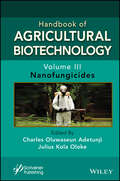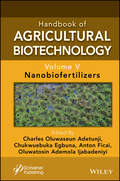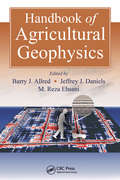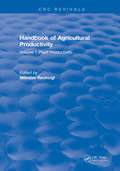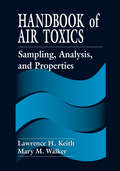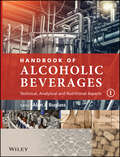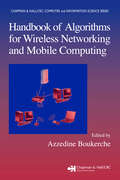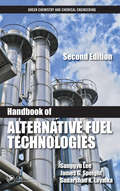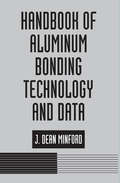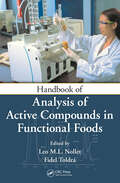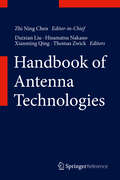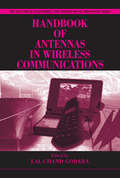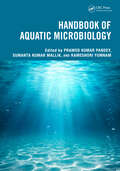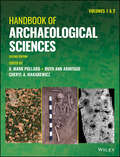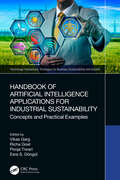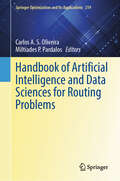- Table View
- List View
Handbook of Agricultural Biotechnology, Volume 3: Nanofungicides (Handbook of Agricultural Bionanobiotechnology)
by Charles Oluwaseun Adetunji Julius Kola OlokeHandbook of AGRICULTURAL BIOTECHNOLOGY This book provides state-of-the-art information about recent advancements in the application of nanobiofungicides for effective management of post-harvest diseases and agricultural fungal diseases, including blights, mildews, molds, and rusts. The book details the formulation and standardization of nanobiofungicides, as well as their application in the management of biotic and abiotic stress. It provides relevant information on the isolation, characterization, purification, and structural characterization of active constituents, using spectroscopic techniques and explains the quarantine and regulatory issues that are associated with nanobiofungicides (derived from plants and other biogenic sources), as well as various regulatory bodies that manage the control of pesticides on agricultural products. Readers will learn about the application of nanobiofungicides when applied as a biocontrol agent against soil-borne and root-borne plant pathogens; the management of mycotoxin; the non-target effect of plant-based nanobiofungicides when applied in the greenhouse and field (such as rate of CO2 evolution, organic carbon content, enzymatic activity, acidic and alkaline phosphatase, dehydrogenases, urease, and protease); and the effect on soil microorganisms using different assay techniques. Furthermore, the book provides information on several plant materials that could serve as nanobiofungicdes, and explains the procedure involved in the characterization of plant-based nanobiofungicides (using TEM, SEM, XRD, EDX, UV, zeta potential, dynamic light-scattering). Finally, it offers a specific illustration on the application of microencapsulation and nanoformulation technology in the synthesis of plant-based nanobiofungicides. Audience The book is a useful resource for a diverse audience, including industrialists, food industry professionals, agriculturists, agricultural microbiologists, plant pathologists, botanists, microbiologists, biotechnologists, nanotechnologists, microbial biotechnologists, farmers, policymakers, and extension workers.
Handbook of Agricultural Biotechnology, Volume 4: Nanoinsecticides (Handbook of Agricultural Bionanobiotechnology)
by Charles Oluwaseun Adetunji Julius Kola OlokeHandbook of AGRICULTURAL BIOTECHNOLOGY The book provides detailed information about the application of repellent products that contain plant-based ingredients known as nanobioinsecticides, including the pesticide evaluation scheme guidelines for repellent testing, relevant information about the procedures to evaluate several repellent compounds, the development of new products that offer high repellency, and guidelines for consumer safety. The chapters of volume IV of this set, focus on a wide range of related topics. They chronicle many traditional repellent plants that could be used in ethnobotanical studies and provides valuable insight into the development of new natural products. It outlines the standardization and numerous investigations used to affirm the level of repellent compounds from various plants. Furthermore, it details the safety, efficacy, and facts about plant-based repellent testing, and reviews new developments in the field. The book also explores the sustainable techniques involved in the structural elucidation and characterization of active constituents found in nanobioinsecticides, and gives relevant information on the use of essential oils, derived from plants, in the preparation of nanobioinsecticides. Audience The book is a useful resource for a diverse audience, including industrialists, food industry professionals, agriculturists, agricultural microbiologists, plant pathologists, botanists, microbiologists, biotechnologists, nanotechnologists, microbial biotechnologists, farmers, policymakers, and extension workers.
Handbook of Agricultural Biotechnology, Volume 5: Nanobiofertilizers (Handbook of Agricultural Bionanobiotechnology)
by Chukwuebuka Egbuna Charles Oluwaseun Adetunji Anton Ficai Oluwatosin Ademola IjabadeniyiThis book details recent advances in the applications of nanobiofertilizers as a substitute for synthetic fertilizers in boosting food production. With the steady rise of the world’s population, there is a need to increase the production of safe and nutritious food. The constant loss of arable land, as a result of various anthropogenic activities from human action, has become a threat to global biodiversity and ecosystems. Additionally, the issue of climate change has imposed many obstacles to increasing agricultural productivity, especially from biotic and abiotic stressors and temperature-limited environments, such as in high altitudes or seasonally hot regions. Because of these factors, there is a need to adopt sustainable and modern technologies that can boost and improve the rate of food production. One of the cheapest means of enhancing sustainable food production is to explore natural and unlimited beneficial microorganisms, particularly those that can increase the level of soil fertility, improve crop production and health, improve tolerance to stress, support nutrient uptake and availability, and boost natural biodiversity. The synergetic effect of nanotechnology and beneficial microorganisms for the effective bio-fabrication of nanobiofertilizers, is a sustainable solution for producing pesticide-free food. This book provides a deep insight into microbial diversity, recent techniques used for the isolation, screening, and characterization of beneficial microorganisms with eco-friendly attributes, used for bioengineering of nanobiofertilizers, as well as the application of proteomics, metabolomics, genomics, and bioinformatics. The book also covers commercialization, patents, and the business and socio-economic aspects of nanobiofertilizers, as well as the role of policymakers, stakeholders, and government agencies in the translation of nanobioferilizer research into policy. Audience The book is a useful resource for a diverse audience, including industrialists, food industry professionals, agriculturists, agricultural microbiologists, plant pathologists, botanists, microbiologists, biotechnologists, nanotechnologists, microbial biotechnologists, farmers, policymakers, and extension workers.
Handbook of Agricultural Geophysics (500 Tips)
by Barry J. Allred Jeffery J. Daniels M. Reza EhsaniPrecision farming, site infrastructure assessment, hydrologic monitoring, and environmental investigations- these are just a few current and potential uses of near-surface geophysical methods in agriculture. Responding to the growing demand for this technology, the Handbook of Agricultural Geophysics supplies a clear, concise overview of nea
Handbook of Agricultural Productivity: Volume I: Plant Productivity (Crc Series In Nutrition And Food)
by Miloslav RechciglThe greatest challenge of our time is to produce sufficient food ot keep pace with the rapidly growing population. In the opinion of experts, during the next 25 years there will be a need for as much food as was produced in the entire history of mankind to date. Of the various measures available, improvement in agricultural productivity is judged as the ultimate means of augmenting food production and supplies. In this Handbook, an international team of experts consider the most important factors affecting production of both crops and livestock. This Handbook is intended as a scientific guide to practitioners and students, as well as to researchers, who should find here stimulating ideas for further exploration.
Handbook of Air Toxics: Sampling, Analysis, and Properties
by Mary Walker Lawrence H. KeithThe Handbook of Air Toxics compiles, defines, and clarifies several methods and concepts of airborne toxic substances found in the environment. This comprehensive reference helps regulators, consultants, and other environmental professionals meet the challenges of sampling and analysis, emissions reductions, and health and safety issues related to human exposure. It is an important reference addressing the ongoing concern about the consequences of air pollution, and the implementation and modification of the Environmental Protection Agency's (EPA) Clean Air Act.Some of the methods described in the Handbook of Air Toxics include fluorescence, thermal desorption, selected ion monitoring, ion chromatography, light microscopy, specific electrode analysis, titration, colorimetry, atomic absorption, and spectrophotometry. It also covers the use of isokinetic sampling trains, midget impingers, carbon molecular sieves, and sampling canisters in the analysis of air toxics. The Handbook also contains recommendations from the EPA for analytical methods for those air toxics where methods do not already exist and provides advance information on future method development by the EPA.
Handbook of Alcoholic Beverages
by Alan J. BuglassA comprehensive two- volume set that describes the science and technology involved in the production and analysis of alcoholic beverages.At the heart of all alcoholic beverages is the process of fermentation, particularly alcoholic fermentation, whereby sugars are converted to ethanol and many other minor products. The Handbook of Alcoholic Beverages tracks the major fermentation process, and the major chemical, physical and technical processes that accompany the production of the world's most familiar alcoholic drinks. Indigenous beverages and small-scale production are alsocovered to asignificant extent.The overall approach is multidisciplinary, reflecting the true nature of the subject. Thus, aspects of biochemistry, biology (including microbiology), chemistry, health science, nutrition, physics and technology are all necessarily involved, but the emphasis is on chemistry in many areas of the book. Emphasis is also on more recent developments and innovations, but there is sufficient background for less experienced readers. The approach is unified, in that although different beverages are dealt with in different chapters, there is extensive cross-referencing and comparison between the subjects of each chapter.Divided into five parts, this comprehensive two-volume work presents:INTRODUCTION, BACKGROUND AND HISTORY: A simple introduction to the history and development of alcohol and some recent trends and developments,FERMENTED BEVERAGES: BEERS, CIDERS, WINES AND RELATED DRINKS: the latest innovations and aspects of the different fermentation processes used in beer, wine, cider, liquer wines, fruit wines, low-alcohol and related beverages.SPIRITS: cover distillation methods and stills used in the production of whisky, cereal- and cane-based spirits, brandy, fruit spirits and liquersANALYTICAL METHODS: covering the monitoring of processes in the production of alcoholic beverages, as well as sample preparation, chromatographic, spectroscopic, electrochemical, physical, sensory and organoleptic methods of analysis.NUTRITION AND HEALTH ASPECTS RELATING TO ALCOHOLIC BEVERAGES: includes a discussion on nutritional aspects, both macro- and micro-nutrients, of alcoholic beverages, their ingestion, absorption and catabolism, the health consequences of alcohol, and details of the additives and residues within the various beverages and their raw materials.
Handbook of Algorithms for Wireless Networking and Mobile Computing (Chapman & Hall/CRC Computer and Information Science Series)
by Azzedine BoukercheThe Handbook of Algorithms for Wireless Networking and Mobile Computing focuses on several aspects of mobile computing, particularly algorithmic methods and distributed computing with mobile communications capability. It provides the topics that are crucial for building the foundation for the design and construction of future generations of mobile and wireless networks, including cellular, wireless ad hoc, sensor, and ubiquitous networks. Following an analysis of fundamental algorithms and protocols, the book offers a basic overview of wireless technologies and networks. Other topics include issues related to mobility, aspects of QoS provisioning in wireless networks, future applications, and much more.
Handbook of Alternative Fuel Technologies (Green Chemistry and Chemical Engineering)
by James G. Speight Sunggyu Lee Sudarshan K. LoyalkaWhile strides are being made in the research and development of environmentally acceptable and more sustainable alternative fuels-including efforts to reduce emissions of air pollutants associated with combustion processes from electric power generation and vehicular transportation-fossil fuel resources are limited and may soon be on the verge of d
Handbook of Aluminum Bonding Technology and Data
by J. D. MinfordA reference that offers comprehensive discussions on every important aspect of aluminum bonding for each level of manufacturing from mill finished to deoxidized, conversion coated, anodized, and painted surfaces and provides an extensive, up-to-date review of adhesion science, covering all significa
Handbook of Aluminum: Volume 2: Alloy Production and Materials Manufacturing
by George E. Totten; D. Scott MacKenzieThis reference provides thorough and in-depth coverage of the latest production and processing technologies encountered in the aluminum alloy industry, discussing current analytical methods for aluminum alloy characterization as well as extractive metallurgy, smelting, master alloy formation, and recycling. The Handbook of Aluminum: Volume 2 examin
Handbook of Analysis and Extraction Methods of Anthocyanins (Food Analysis & Properties)
by Semih Ötleş Nollet, Leo M.L.Handbook of Analysis and Extraction Methods of Anthocyanins provides a comprehensive guide to learning about the properties of anthocyanins, which have gained increasing importance in recent years and have attracted widespread attention from industry, academia, and government, as well as the precise, applicable, and modern methods of their analysis developed to date. The first part of the book introduces the structure, biochemical properties, health effects, and high antioxidant capacity of anthocyanins based on scientific developments in recent years. The second part of the book is aimed at the technological use of anthocyanins in industry, focusing on the effects of food processing methods on anthocyanins, encapsulation, the possibilities of using them as colorants in industry, and their importance as a functional ingredient, as well as a healthy ingredient. The third part of the book presents in detail the extraction and purification methods of anthocyanins in different food products as well as sensitive, quantitative, applicable, and newly developed NMR, HPLC, UHPLC, GC/MS, UHPLC/MS, and LC/MS methods. Key Features: Minimal Prerequisites: No prior functional food experience is needed, making the content accessible to a wide audience. New and Real-World Data: Learn with real-scientific information on anthocyanins, including all biological properties of anthocyanins, antioxidant activities, and new datasets on health protection, functional food development, encapsulation, and uses of anthocyanins as food colorant. Expanded Theoretical and Practical Data on Methods of Analysis of Anthocyanins: Includes deeper coverage of theory-based approaches of modern methods of analysis of anthocyanins, their connection with GC/MS, LC/MS etc.-based approaches, and a presentation of newly developed and formal aspects of these methods of anthocyanins. Ideal for those interested in or looking to deepen their knowledge of functional foods and nutraceuticals, this edition provides a clear introduction to the antioxidant structure and health-protective properties of anthocyanins and current modern analysis methods.
Handbook of Analysis of Active Compounds in Functional Foods
by Fidel Toldrá Leo M.L. NolletFunctional foods offer specific benefits that enhance life and promote longevity, and the active compounds responsible for these favorable effects can be analyzed through a range of techniques. Handbook of Analysis of Active Compounds in Functional Foods presents a full overview of the analytical tools available for the analysis of active ingredien
Handbook of Analysis of Edible Animal By-Products
by Leo M.L. Nollet Fidel ToldrÁWhile muscle foods are the more commonly consumed portion of an animal, animal by-products such as the entrails and internal organs are also widely consumed. This handbook, unique in the world, provides food scientists with a full overview of the tools available for the analysis of these by-products. Known for their superior handbooks on processed meats and poultry, muscle meat, dairy, and seafood, editors Nollet and Todra take the same comprehensive approach. They bring together leading experts who look at the techniques and methodologies for analyzing nutritional and sensory qualities as well as safety, includingthe detection of pathogens and toxins usually found in muscle foods.
Handbook of Animal-Based Fermented Food and Beverage Technology
by Y. H. HuiFermented food can be produced with inexpensive ingredients and simple techniques and makes a significant contribution to the human diet, especially in rural households and village communities worldwide. Progress in the biological and microbiological sciences involved in the manufacture of these foods has led to commercialization and heightened int
Handbook of Antenna Technologies
by Thomas Zwick Hisamatsu Nakano Zhi Ning Chen Duixian Liu Xianming QingThis Handbook aims to present the rapid development of antenna technologies, particularly in the past two decades, and also showcasing the newly developed technologies and the latest applications. The handbook will provide readers with the comprehensive updated reference information covering theory, modeling and optimization methods, design and measurement, new electromagnetic materials, and applications of antennas. The handbook will widely cover not only all key antenna design issues but also fundamentals, issues related to antennas (transmission, propagation, feeding structure, materials, fabrication, measurement, system, and unique design challenges in specific applications). This handbook will benefit the readers as a full and quick technical reference with a high-level historic review of technology, detailed technical descriptions and the latest practical applications.
Handbook of Antennas in Wireless Communications (Electrical Engineering & Applied Signal Processing Series #4)
by Lal Chand GodaraThe move toward worldwide wireless communications continues at a remarkable pace, and the antenna element of the technology is crucial to its success. With contributions from more than 30 international experts, the Handbook of Antennas in Wireless Communications brings together all of the latest research and results to provide engineering professionals and students with a one-stop reference on the theory, technologies, and applications for indoor, hand-held, mobile, and satellite systems.Beginning with an introduction to wireless communications systems, it offers an in-depth treatment of propagation prediction and fading channels. It then explores antenna technology with discussion of antenna design methods and the various antennas in current use or development for base stations, hand held devices, satellite communications, and shaping beams. The discussions then move to smart antennas and phased array technology, including details on array theory and beamforming techniques. Space diversity, direction-of-arrival estimation, source tracking, and blind source separation methods are addressed, as are the implementation of smart antennas and the results of field trials of systems using smart antennas implemented. Finally, the hot media topic of the safety of mobile phones receives due attention, including details of how the human body interacts with the electromagnetic fields of these devices.Its logical development and extensive range of diagrams, figures, and photographs make this handbook easy to follow and provide a clear understanding of design techniques and the performance of finished products. Its unique, comprehensive coverage written by top experts in their fields promises to make the Handbook of Antennas in Wireless Communications the standard reference for the field.
Handbook of Antioxidants (Oxidative Stress and Disease)
by Enrique Cadenas Lester PackerContains new and expanded material on antioxidants in beverages and herbal products, nitric oxide and selenium, and the effect of vitamin C on cardiovascular disease and of lipoic acid on aging, hyperglycemia, and insulin resistance! Offering over 4200 contemporary references-2000 more than the previous edition-the Second Edition of the Handbook of Antioxidants is an up-to-the-minute source for nutritionists and dietitians, cell biologists and biochemists, cardiologists, oncologists, dermatologists, and medical students in these disciplines.
Handbook of Applied Hydrologic and Water Resources Engineering
by Vijay P. Singh Raveendra Kumar Rai Chandra Shekhar OjhaThe Handbook of Applied Hydrologic and Water Resources Engineering examines the planning and design of water supply systems, flood control works, drought mitigation measures, navigation facilities, and hydraulic structures, as well as feasibility and environmental impact studies for various water-related projects. It is based on the experience gained through consultancy in dealing with various water resources issues and problems, teaching, and research. It serves as a useful resource for graduate students and faculty members in civil engineering, agricultural engineering, and water resources engineering, as well as practicing engineers working in civil, environmental, and agricultural fields.
Handbook of Applied Polymer Processing Technology (Plastics Engineering Ser. #31)
by Nicholas P. Cheremisinoff Paul N. Cheremisinoff"Offers detailed coverage of applied polymer processing--presenting a wide range of technologies and furnishing state-of-the-art data on polymer components, properties, and processibility. Reviews fundamental rheological concepts. Contains over 1600 bibliographic citations, some 450 equations, and over 400 tables, drawings, and photographs."
Handbook of Aquatic Microbiology
by Pramod Kumar Pandey, Sumanta Kumar Mallik, and Rameshori YumnamShort Blurb This handbook covers the different aspects of the aquatic environment, microbiology, and microbial applications. It highlights the role of microorganisms as pollution indicators and as bio-control agents. The book covers the impact of pollution on microorganisms, biofilms, cyanobacterial blooms, and the metagenomics approach to isolate microbes. Standard Blurb This comprehensive handbook covers the different aspects of the aquatic environment, microbiology, and microbial applications. The world’s aquatic environment is facing a serious threat due to inappropriate planning, implementation, and management. This book compiles effective strategies for managing the aquatic environment. It highlights the role of microorganisms as pollution indicators, in bioremediation, and as bio-control agents. The book also covers the impact of pollution on microorganisms, biofilms, cyanobacterial blooms, and the metagenomics approach to isolate microbes. This book is essential for students and researchers of microbiology, environmental sciences, and biotechnology Seasonal Blurb This comprehensive handbook covers the different aspects of the aquatic environment, microbiology, and microbial applications. The world’s aquatic environment is facing a serious threat due to inappropriate planning, implementation, and management. This book compiles effective strategies for managing the aquatic environment. It highlights the role of microorganisms as pollution indicators, in bioremediation, and as bio-control agents. The book also covers the impact of pollution on microorganisms, biofilms, cyanobacterial blooms, and the metagenomics approach to isolate microbes. This book is essential for students and researchers of Microbiology, Environmental Sciences, and Biotechnology. 1 Includes key themes like environmental DNA application, metagenomes, extremophiles, microbial population genetics and statistical aspects of aquatic microbiology 2 Discusses the beneficial microbes of the aquatic environment 3 Covers applications of microbes in bioremediation, as pollution indicators and as algicidal agents 4 Reviews freshwater biogeochemical cycles and sediment microbiology 5 Explores microbial communities of biofloc and microbiomes in aquaponics
Handbook of Archaeological Sciences
by Cheryl A. Makarewicz A. Mark Pollard Ruth Ann ArmitageHANDBOOK OF ARCHAEOLOGICAL SCIENCES A modern and comprehensive introduction to methods and techniques in archaeology In the newly revised Second Edition of the Handbook of Archaeological Sciences, a team of more than 100 researchers delivers a comprehensive and accessible overview of modern methods used in the archaeological sciences. The book covers all relevant approaches to obtaining and analyzing archaeological data, including dating methods, quaternary paleoenvironments, human bioarchaeology, biomolecular archaeology and archaeogenetics, resource exploitation, archaeological prospection, and assessing the decay and conservation of specimens. Overview chapters introduce readers to the relevance of each area, followed by contributions from leading experts that provide detailed technical knowledge and application examples. Readers will also find: A thorough introduction to human bioarchaeology, including hominin evolution and paleopathology The use of biomolecular analysis to characterize past environments Novel approaches to the analysis of archaeological materials that shed new light on early human lifestyles and societies In-depth explorations of the statistical and computational methods relevant to archaeology Perfect for graduate and advanced undergraduate students of archaeology, the Handbook of Archaeological Sciences will also earn a prominent place in the libraries of researchers and professionals with an interest in the geological, biological, and genetic basis of archaeological studies.
Handbook of Artificial Intelligence in Healthcare: Vol 2: Practicalities and Prospects (Intelligent Systems Reference Library #212)
by Lakhmi C. Jain Yen-Wei Chen Chee-Peng Lim Ashlesha Vaidya Charu MahorkarArtificial Intelligence (AI) has transformed many aspects of our daily activities. Health and well-being of humans stand as one of the key domains where AI has achieved significant progresses, saving time, costs, and potentially lives, as well as fostering economic resilience, particularly under the COVID-19 pandemic environments. This book is a sequel of the Handbook of Artificial Intelligence in Healthcare. The first volume of the Handbook is dedicated to present advances and applications of AI methodologies in several specific areas, i.e., signal, image, and video processing as well as information and data analytics. In this second volume of the Handbook, general practicality challenges and future prospects of AI methodologies pertaining to healthcare and related domains are presented in Part 1 and Part 2, respectively. It is envisaged that the selected studies will provide readers a general perspective on the issues, challenges, and opportunities in designing, developing, and implementing AI-based tools and solutions in the healthcare sector, bringing benefits to transform and advance health and well-being development of humans..
Handbook of Artificial Intelligence Applications for Industrial Sustainability: Concepts and Practical Examples (Technology Innovations)
by Vikas Garg Pooja Tiwari Richa Goel Esra S. DöngülThe subject of Artificial Intelligence (AI) is continuing on its journey of affecting each and every individual and will keep on this path in the times to come. This handbook is a collection of topics on the application of artificial intelligence applications for sustainability in different areas. It provides an insight into the various uses of concepts and practical examples for different domains all in one place, which makes it unique and important for the potential reader.Handbook of Artificial Intelligence Applications for Industrial Sustainability: Concepts and Practical Examples examines the influence of AI and how it can be used in several industries to improve corporate performance, reduce security concerns, improve customer experience, and ultimately generate value for customers and maximize profits. The handbook offers practical examples, concepts, and applications that provide an easy understanding and implementation process. It provides AI applications in many fields, such as sustainable credit decisions, cyber security and fraud prevention, warehouse management, and much more.This handbook will provide insight to customers, managers, professionals, engineers, researchers, and students on the various uses of AI and sustainability in different domains. All of this needed information compiled into one handbook makes it unique and important for the engineering, business, and computer science communities.
Handbook of Artificial Intelligence and Data Sciences for Routing Problems (Springer Optimization and Its Applications #219)
by Carlos A. S. Oliveira Miltiades P. PardalosThis handbook delves into the rapidly evolving field of artificial intelligence and optimization, focusing on the intersection of machine learning, combinatorial optimization, and real-world applications in transportation and network design. Covering an array of topics from classical optimization problems such as the Traveling Salesman Problem and the Knapsack Problem, to modern techniques including advanced heuristic methods, Generative Adversarial Networks, and Variational Autoencoders, this book provides a roadmap for solving complex problems. The included case studies showcase practical implementations of algorithms in predicting route sequences, traffic management, and eco-friendly transportation. This comprehensive guide is essential for researchers, practitioners, and students interested in AI and optimization. Whether you are a researcher seeking standard approaches or a professional looking for practical solutions to industry challenges, this book offers valuable insights into modern AI algorithms.
